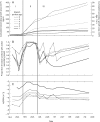Insights into secondary growth in perennial plants: its unequal spatial and temporal dynamics in the apple (Malus domestica) is driven by architectural position and fruit load
- PMID: 20228088
- PMCID: PMC2850790
- DOI: 10.1093/aob/mcq006
Insights into secondary growth in perennial plants: its unequal spatial and temporal dynamics in the apple (Malus domestica) is driven by architectural position and fruit load
Abstract
Background and aims: Secondary growth is a main physiological sink. However, the hierarchy between the processes which compete with secondary growth is still a matter of debate, especially on fruit trees where fruit weight dramatically increases with time. It was hypothesized that tree architecture, here mediated by branch age, is likely to have a major effect on the dynamics of secondary growth within a growing season.
Methods: Three variables were monitored on 6-year-old 'Golden Delicious' apple trees from flowering time to harvest: primary shoot growth, fruit volume, and cross-section area of branch portions of consecutive ages. Analyses were done through an ANOVA-type analysis in a linear mixed model framework.
Key results: Secondary growth exhibited three consecutive phases characterized by unequal relative area increment over the season. The age of the branch had the strongest effect, with the highest and lowest relative area increment for the current-year shoots and the trunk, respectively. The growth phase had a lower effect, with a shift of secondary growth through the season from leafy shoots towards older branch portions. Eventually, fruit load had an effect on secondary growth mainly after primary growth had ceased.
Conclusions: The results support the idea that relationships between production of photosynthates and allocation depend on both primary growth and branch architectural position. Fruit load mainly interacted with secondary growth later in the season, especially on old branch portions.
Figures




Similar articles
-
Simulation of carbon allocation and organ growth variability in apple tree by connecting architectural and source-sink models.Ann Bot. 2016 Aug;118(2):317-30. doi: 10.1093/aob/mcw085. Epub 2016 Jun 8. Ann Bot. 2016. PMID: 27279576 Free PMC article.
-
Architecture of the pruned tree: impact of contrasted pruning procedures over 2 years on shoot demography and spatial distribution of leaf area in apple (Malus domestica).Ann Bot. 2007 Jun;99(6):1055-65. doi: 10.1093/aob/mcm049. Epub 2007 Apr 7. Ann Bot. 2007. PMID: 17416911 Free PMC article.
-
Influence of the variation of geometrical and topological traits on light interception efficiency of apple trees: sensitivity analysis and metamodelling for ideotype definition.Ann Bot. 2014 Sep;114(4):739-52. doi: 10.1093/aob/mcu034. Ann Bot. 2014. PMID: 24723446 Free PMC article.
-
Tracing a key player in the regulation of plant architecture: the columnar growth habit of apple trees (Malus × domestica).Planta. 2013 Jul;238(1):1-22. doi: 10.1007/s00425-013-1898-9. Epub 2013 May 22. Planta. 2013. PMID: 23695821 Review.
-
The role of branch architecture in assimilate production and partitioning: the example of apple (Malus domestica).Front Plant Sci. 2014 Jul 9;5:338. doi: 10.3389/fpls.2014.00338. eCollection 2014. Front Plant Sci. 2014. PMID: 25071813 Free PMC article. Review.
Cited by
-
Maximum Growth Potential and Periods of Resource Limitation in Apple Tree.Front Plant Sci. 2016 Feb 29;7:233. doi: 10.3389/fpls.2016.00233. eCollection 2016. Front Plant Sci. 2016. PMID: 26973676 Free PMC article.
-
Relationships between trunk radial growth and fruit yield in apple and pear trees on size-controlling rootstocks.Ann Bot. 2022 Sep 26;130(4):477-489. doi: 10.1093/aob/mcac089. Ann Bot. 2022. PMID: 35788818 Free PMC article.
-
Deciphering the Costs of Reproduction in Mango - Vegetative Growth Matters.Front Plant Sci. 2016 Oct 21;7:1531. doi: 10.3389/fpls.2016.01531. eCollection 2016. Front Plant Sci. 2016. PMID: 27818665 Free PMC article.
References
-
- Barnola P, Crabbé J. L'activité cambiale, composante active ou passive dans les réactions de croissance de l'arbre ? Acta Botanica Gallica. 1993;140:403–412.
-
- Bijhouwer J. De periodiciteit van de knopontwikkeling bij den appel. Mededeelingen van de Landbouwhoogeschool. 1924;27:1–69.
-
- Bound SA. Managing crop load. In: Dris RNR, Niskanen R, Jain SM, editors. Crop management and postharvest handling of horticultural products. I. Quality management. Enfield, NH, USA: Science Publishers; 2001. pp. 89–110.
-
- Briand CH, Daniel AD, Wilson KA, Woods HE. Allometry of axis length, diameter, and taper in the devil's walking stick (Aralia spinosa; Araliaceae) American Journal of Botany. 1998;85:1201–1206. - PubMed
-
- Brouat C, Gibernau M, Amsellem L, McKey D. Corner's rules revisited: ontogenetic and interspecific patterns in leaf-stem allometry. New Phytologist. 1998;139:459–470.

